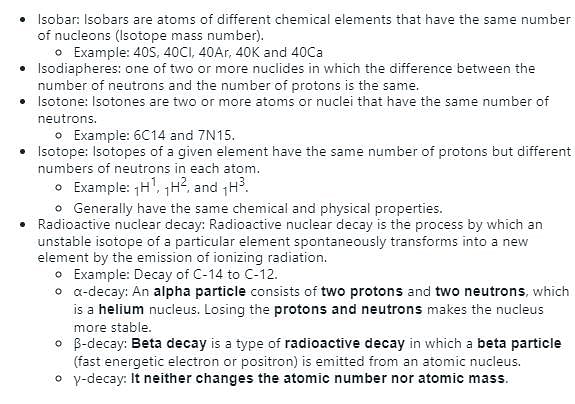Chemistry Exam > Chemistry Tests > Inorganic Chemistry > Test: Half Life Time, Mean Life & Radioactivity Series - Chemistry MCQ
Test: Half Life Time, Mean Life & Radioactivity Series - Chemistry MCQ
Test Description
10 Questions MCQ Test Inorganic Chemistry - Test: Half Life Time, Mean Life & Radioactivity Series
Test: Half Life Time, Mean Life & Radioactivity Series for Chemistry 2024 is part of Inorganic Chemistry preparation. The Test: Half Life Time, Mean Life & Radioactivity Series questions and answers have been
prepared according to the Chemistry exam syllabus.The Test: Half Life Time, Mean Life & Radioactivity Series MCQs are made for Chemistry 2024 Exam. Find important
definitions, questions, notes, meanings, examples, exercises, MCQs and online tests for Test: Half Life Time, Mean Life & Radioactivity Series below.
Solutions of Test: Half Life Time, Mean Life & Radioactivity Series questions in English are available as part of our Inorganic Chemistry for Chemistry & Test: Half Life Time, Mean Life & Radioactivity Series solutions in
Hindi for Inorganic Chemistry course. Download more important topics, notes, lectures and mock
test series for Chemistry Exam by signing up for free. Attempt Test: Half Life Time, Mean Life & Radioactivity Series | 10 questions in 10 minutes | Mock test for Chemistry preparation | Free important questions MCQ to study Inorganic Chemistry for Chemistry Exam | Download free PDF with solutions
Test: Half Life Time, Mean Life & Radioactivity Series - Question 1
What is the half-life of a radioactive element?
Detailed Solution for Test: Half Life Time, Mean Life & Radioactivity Series - Question 1
Test: Half Life Time, Mean Life & Radioactivity Series - Question 2
What is the unit of half-life?
Detailed Solution for Test: Half Life Time, Mean Life & Radioactivity Series - Question 2
| 1 Crore+ students have signed up on EduRev. Have you? Download the App |
Test: Half Life Time, Mean Life & Radioactivity Series - Question 3
Which formula represents the relation between half-life (T1/2) and the number of half-lives (n)?
Detailed Solution for Test: Half Life Time, Mean Life & Radioactivity Series - Question 3
Test: Half Life Time, Mean Life & Radioactivity Series - Question 4
What is the mean life of a radioactive material?
Detailed Solution for Test: Half Life Time, Mean Life & Radioactivity Series - Question 4
Test: Half Life Time, Mean Life & Radioactivity Series - Question 5
What is the relationship between mean life (t) and half-life (T1/2)?
Detailed Solution for Test: Half Life Time, Mean Life & Radioactivity Series - Question 5
Test: Half Life Time, Mean Life & Radioactivity Series - Question 6
Which type of radiation has the greatest ionizing power?
Detailed Solution for Test: Half Life Time, Mean Life & Radioactivity Series - Question 6
Test: Half Life Time, Mean Life & Radioactivity Series - Question 7
Which type of radiation has a continuous energy spectrum?
Detailed Solution for Test: Half Life Time, Mean Life & Radioactivity Series - Question 7
Test: Half Life Time, Mean Life & Radioactivity Series - Question 8
What is the range of alpha particles in air?
Detailed Solution for Test: Half Life Time, Mean Life & Radioactivity Series - Question 8
Test: Half Life Time, Mean Life & Radioactivity Series - Question 9
A radioactive nucleus (Parent) emits one alpha and two beta particles, and then the daughter nucleus is:
Detailed Solution for Test: Half Life Time, Mean Life & Radioactivity Series - Question 9
Test: Half Life Time, Mean Life & Radioactivity Series - Question 10
What is the unit of radioactivity?
Detailed Solution for Test: Half Life Time, Mean Life & Radioactivity Series - Question 10
|
48 videos|92 docs|41 tests
|
Information about Test: Half Life Time, Mean Life & Radioactivity Series Page
In this test you can find the Exam questions for Test: Half Life Time, Mean Life & Radioactivity Series solved & explained in the simplest way possible.
Besides giving Questions and answers for Test: Half Life Time, Mean Life & Radioactivity Series, EduRev gives you an ample number of Online tests for practice



















